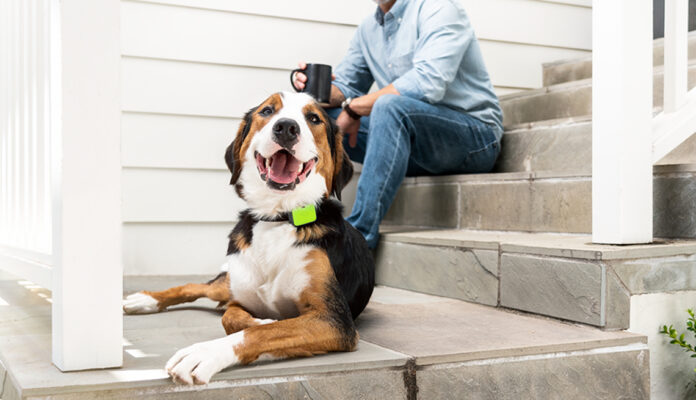The relationship between humans and their pets has evolved into a partnership, with technology playing a pivotal role in ensuring the well-being and safety of our furry companions.
While traditional pet collars with ID tags remain essential, the advent of pet wearables has transformed how we care for and connect with our pets.
Beyond basic location tracking, emerging trends in pet wearables encompass a range of functionalities that contribute to the health, happiness, and overall quality of life of our four-legged friends.
1. Health Monitoring Beyond Steps

Pet wearables are stepping into the realm of health monitoring, providing pet owners with insights beyond basic activity tracking. Modern devices can monitor a pet’s heart rate, respiratory rate, and even sleep patterns.
This level of health data allows owners and veterinarians to detect early signs of illness, ensuring timely and proactive care.
2. Temperature and Environment Sensors
Ensuring the comfort of pets in varying environments is a key concern for pet owners. Advanced pet wearables now come equipped with temperature and environment sensors.
These sensors provide real-time data about the ambient temperature, allowing owners to make informed decisions to keep their pets safe and comfortable.
3. GPS and Geo-Fencing

While GPS tracking is a foundational feature, its application (https://geozilla.com) has become more sophisticated. Pet wearables now offer precise location tracking with geo-fencing capabilities.
This means that owners can establish virtual boundaries, receiving alerts if their pet ventures beyond a predefined area. This feature is particularly valuable for preventing escapes and ensuring the safety of pets.
4. Behavior Monitoring and Training
Understanding and modifying pet behavior is a common challenge for owners. Advanced pet wearables incorporate behavior monitoring features that detect patterns and changes in behavior.
Some devices even offer training modules, allowing owners to remotely train and communicate with their pets through the wearable device.
5. Emotional Well-Being Insights

The emotional well-being of pets is gaining prominence, and pet wearables are now designed to provide insights into a pet’s emotional state.
This may involve monitoring stress levels, detecting signs of anxiety, or even interpreting vocalizations to gauge a pet’s mood. Such insights empower owners to create environments that promote emotional well-being.
6. Biometric Identification
Pet wearables are increasingly integrating biometric identification features. This includes biometric scanning technologies such as fingerprint or paw print recognition.
These features not only enhance security by ensuring that only authorized individuals can access a pet’s wearable but also add a personal touch to pet identification.
7. Social Connectivity for Pets

Recognizing the social nature of pets, some wearables facilitate social connectivity among animals. Owners can set up playdates or meetups based on the proximity of other pets wearing compatible devices.
This social interaction contributes to the mental stimulation and overall happiness of pets.
8. Augmented Reality (AR) Features
Augmented reality is making its way into the realm of pet wearables. Some devices offer AR features that allow owners to visualize data, such as a pet’s location or health metrics, in real-world environments through their smartphones. This adds a layer of interactivity and engagement for pet owners.
9. Integration with Smart Home Systems

The integration of pet wearables with smart home systems is a growing trend. This enables seamless collaboration between the wearable device and other smart home devices.
For example, a pet door connected to the wearable can automatically open when the pet approaches, offering convenience and security.
10. Continuous Software Updates
Pet wearables, like their human-centric counterparts, benefit from continuous software updates. These updates not only introduce new features but also enhance the overall performance and security of the device.
This ensures that pet owners can leverage the latest advancements in pet wearable technology.
11. Nutritional Insights and Dietary Recommendations

Understanding a pet’s nutritional needs is crucial for their health. Some pet wearables integrate with feeding systems, providing insights into a pet’s eating habits.
This data can be used to offer personalized dietary recommendations, ensuring that pets receive the right nutrition based on their individual needs.
12. Sustainable and Comfortable Design
Pet wearables are evolving in terms of design, with an emphasis on sustainability and comfort. Lightweight and eco-friendly materials are becoming standard, ensuring that pets can wear these devices comfortably for extended periods.
Comfortable design contributes to the seamless integration of wearables into a pet’s daily life.
13. Advanced Veterinary Telemedicine Integration

In response to the growing trend of telemedicine, some pet wearables integrate with veterinary telemedicine services. This allows owners to consult with veterinarians remotely, sharing health data and receiving professional guidance without the need for a physical visit.
14. Biometric Feedback for Pet Owners
Pet wearables are expanding their utility to benefit pet owners as well. Some devices provide biometric feedback for owners, such as stress indicators or activity levels.
This feedback fosters a deeper understanding of a pet’s needs and strengthens the bond between owners and their furry companions.
15. Customization and Personalization

The trend towards customization and personalization continues to grow. Pet wearables now offer a range of customizable features, from the appearance of the device to the type of data displayed.
This allows owners to tailor the wearable experience to suit the unique needs and preferences of their pets.
Conclusion
The evolution of pet wearables goes beyond mere location tracking, embracing a holistic approach to pet care. These devices are becoming integral tools that contribute to the health, happiness, and safety of our beloved pets.
As technology continues to advance, the trends in pet wearables are set to redefine the standard of care for pets, enriching the lives of both animals and their human companions.








